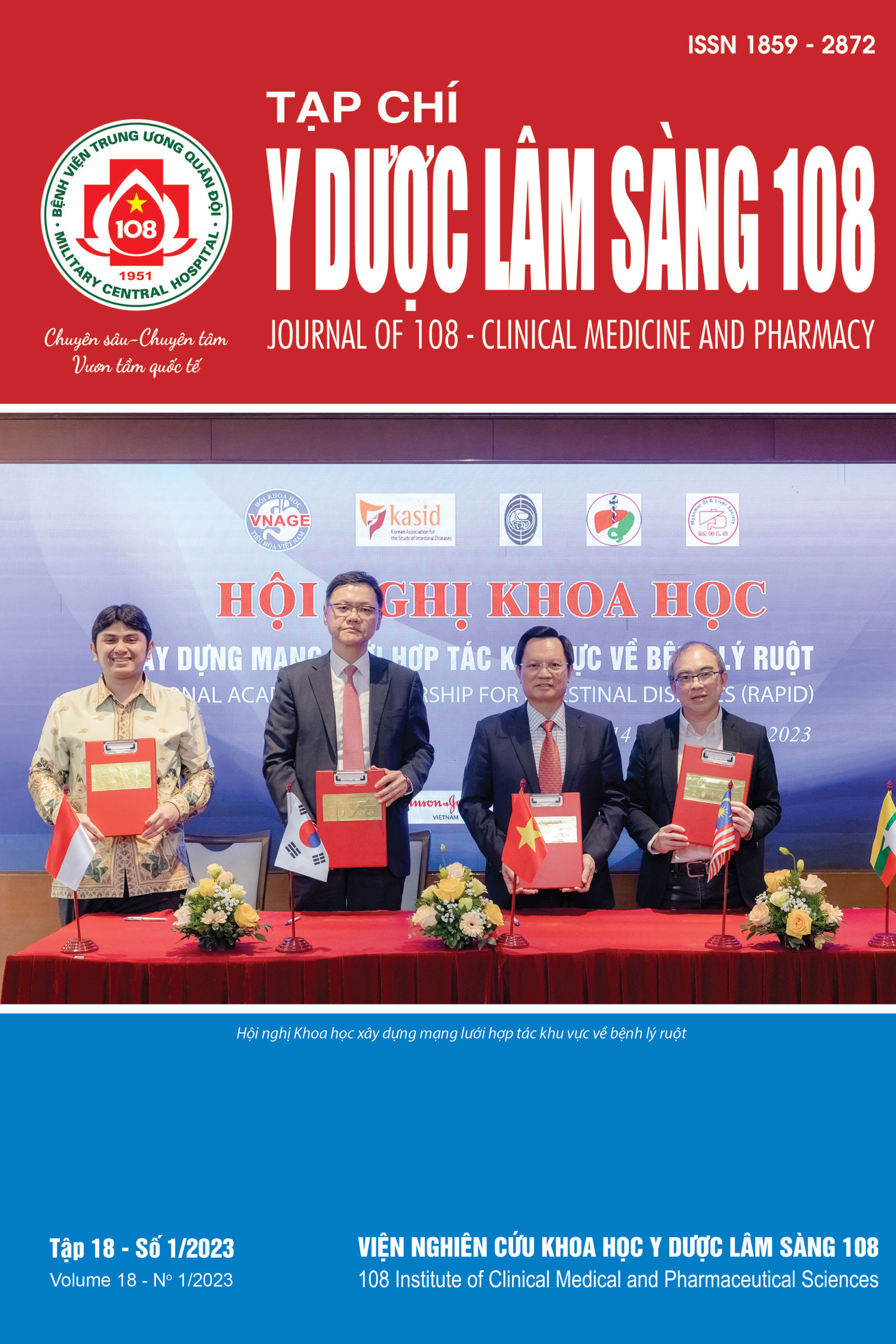Circulating PD-L1 in advanced non-small cell lung cancer and the correlation between the level of PD-L1 concentration and clinical and survival characteristics
Main Article Content
Keywords
Abstract
Objective: To evaluate soluble PD-L1 concentration and relationship between soluble PD-L1 concentration with clinical and survival characteristics in advanced non-small cell lung cancer (NSCLC) patients. Subject and method: 50 patients with advanced NSCLC were treated at Respiratory Center, 103 Military Hospital from January to September 2019. The control group was 30 chronic obstructive pulmonary disease (COPD) patients and 30 healthy people. sPD-L1 was quantified according to the ELISA principle on serum samples. Result: The sPD-L1 concentration of advanced NSCLC group was 2.11 ± 1.48ng/mL, statistically significant difference compared with COPD group 0.98 ± 0.49ng/mL (p<0.001) and healthy group 0.73 ± 0.57ng/mL (p<0.001). At the cut-off point of 0.92ng/mL, sPD-L1 had diagnostic value for advanced NSCLC with sensitivity 74%, specificity 76.7%. The survival time of group with sPD-L1 ± 0.92ng/mL tended to be worse than that of group with sPD-L1 < 0.92ng/mL (17.10 ± 2.82 versus 22.67 ± 4.23 months (p=0.545)). Conclusion: sPD-L1 was elevated in NSCLC patients and can be an immunological marker in diagnosis and prognosis.
Article Details
References
2. Cheng S, Zheng J, Zhu J, Xie C, Zhang X, Han X, Song B, Ma Y, Liu J (2015) PD-L1 gene polymorphism and high level of plasma soluble PD-L1 protein may be associated with non-small cell lung cancer. Int J Biol Markers 30(4): 364-368.
3. Zhang J, Gao J, Li Y, Nie J, Dai L, Hu W, Chen X, Han J, Ma X, Tian G, Wu D, Shen L, Fang J (2015) Circulating PD-L1 in NSCLC patients and the correlation between the level of PD-L1 expression and the clinical characteristics. Thorac Cancer 6(4): 534-538.
4. Okuma Y, Hosomi Y, Nakahara Y, Watanabe K, Sagawa Y, Homma S (2017) High plasma levels of soluble programmed cell death ligand 1 are prognostic for reduced survival in advanced lung cancer. Lung Cancer 104: 1-6.
5. Nagato T, Ohkuri T, Ohara K, Hirata Y, Kishibe K, Komabayashi Y, Ueda S, Takahara M, Kumai T, Ishibashi K, Kosaka A, Aoki N, Oikawa K, Uno Y, Akiyama N, Sado M, Takei H, Celis E, Harabuchi Y, Kobayashi H (2017) Programmed death-ligand 1 and its soluble form are highly expressed in nasal natural killer/T-cell lymphoma: A potential rationale for immunotherapy. Cancer Immunol Immunother 66(7): 877-890.
6. Finkelmeier F, Canli O, Tal A, Pleli T, Trojan J, Schmidt M, Kronenberger B, Zeuzem S, Piiper A, Greten F R, Waidmann O (2016) High levels of the soluble programmed death-ligand (sPD-L1) identify hepatocellular carcinoma patients with a poor prognosis. Eur J Cancer 59: 152-159.
7. Huang SY, Lin HH, Lin C W, Li CC, Yao M, Tang JL, Hou HA, Tsay W, Chou SJ, Cheng CL, Tien HF (2016) Soluble PD-L1: A biomarker to predict progression of autologous transplantation in patients with multiple myeloma. Oncotarget 7(38): 62490-62502.
8. He J, Pan Y, Guo Y, Li B, Tang Y (2020) Study on the Expression Levels and Clinical Significance of PD-1 and PD-L1 in Plasma of NSCLC Patients. J Immunother 43(5): 156-164.
9. Ando K, Hamada K, Watanabe M, Ohkuma R, Shida M, Onoue R, Kubota Y, Matsui H, Ishiguro T, Hirasawa Y, Ariizumi H, Tsurutani J, Yoshimura K, Tsunoda T, Kobayashi S, Wada S (2019) Plasma Levels of Soluble PD-L1 Correlate With Tumor Regression in Patients With Lung and Gastric Cancer Treated With Immune Checkpoint Inhibitors. Anticancer Res 39(9): 5195-5201.
10. Murakami S, Shibaki R, Matsumoto Y, Yoshida T, Goto Y, Kanda S, Horinouchi H, Fujiwara Y, Yamamoto N, Ohe Y (2020) Association between serum level soluble programmed cell death ligand 1 and prognosis in patients with non-small cell lung cancer treated with anti-PD-1 antibody. Thorac Cancer 11(12): 3585-3595.
 ISSN: 1859 - 2872
ISSN: 1859 - 2872
